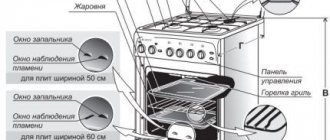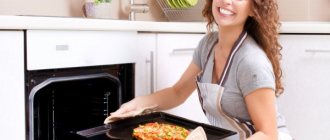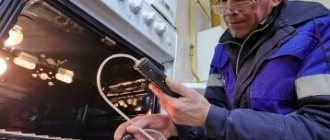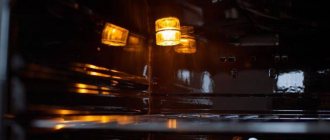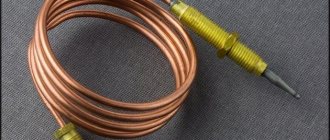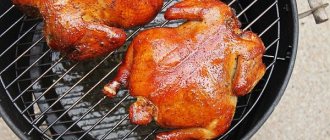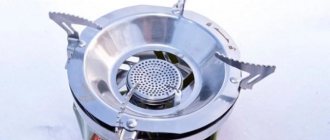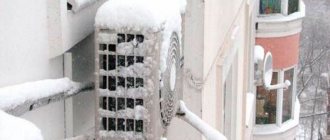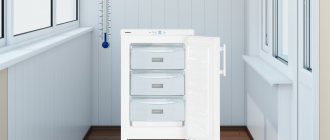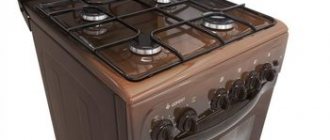Experienced cooks who have been preparing the same dishes for many years and using the same oven can easily determine the heating temperature, even without paying attention to the thermostat marks. It is enough to install the handle in the usual position and after a few minutes enjoy the result. But if the oven is new or the recipe requires precise adherence to the temperature regime, and the thermometer does not work or is missing altogether, then you will have to deal with the thermostat scale, which completely lacks any symbols.
Comparison of measurement scales
If you have a passport for the stove and the operating instructions, it will not be difficult to determine how many degrees in the oven of your gas stove at a certain position of the control knob. This data is available in the relevant documents.
If we are talking about a stove made more than 20 years ago, the instructions for which were lost in the last century, you have to rely only on average indicators, as well as your own experience.
Old-style gas stoves are not much different from each other. The maximum oven heating in these models is limited to 280 °C, the minimum - 150 °C. The scale of the adjusting knob has 8 divisions. Based on these parameters, we obtain markup with the following data:
Articles on the topic (click to view)
- Rating of the best steamers of 2022
- Photos of curtains for kitchen design 2022
- Choosing curtains for the kitchen
- Metal kitchen rack for appliances
- Instructions for the electric stove "classic plus"
- How to choose an electric stove with 4 burners and an oven for the kitchen
- Sofa in the bay window for the kitchen
- One division corresponds to approximately 20 °C;
- It is impossible to create a temperature of less than 150 °C using the regulator. But if you need to reduce the heat, for example, to prepare meringues or dry herbs, open the oven door slightly and thus regulate the heat.
These parameters are average and applicable to most gas stoves, but are not a direct guide to action. In addition, long-term use of kitchen appliances may make certain adjustments; the heat level may drop significantly or significantly exceed the specified parameters.
Tip: if there is no thermometer inside the oven, it is recommended to experimentally check the accuracy of the thermostat at least once a year.
How to find out the temperature in the oven by marks
How to determine the temperature in the oven by marks, without a thermometer, if the minimum and maximum values do not fit into the “average” category? In addition, some models provide more precise temperature control and the number of divisions on the handle reaches 9 or 10 units. Others may have only 5 divisions and choosing the most accurate temperature is quite difficult.
That is why manufacturers of some gas stoves include tables with their products that will help you figure out if the oven should be 180 degrees, how many units there are on the regulator.
A breakdown of the scale is also offered for other temperature regimes that are most popular in cooking.
tmin — 170, tmax — 266, number of divisions: 5
| Division on the control knob | t, °С |
| 1 | 170 |
| 2 | 230 |
| 3 | 236 |
| 4 | 253 |
| 5 | 266 |
tmin — 135, tmax — 270, number of divisions: 7
tmin — 135, tmax — 250, number of divisions: 8
| Division on the control knob | t, °С |
| 1 | 135 |
| 2 | 150 |
| 3 | 165 |
| 4 | 180 |
| 5 | 195 |
| 6 | 210 |
| 7 | 230 |
| 8 | 250 |
tmin — 150, tmax — 280, number of divisions: 8
| Division on the control knob | t, °С |
| 1 | 150 |
| 2 | 160 |
| 3 | 180 |
| 4 | 200 |
| 5 | 220 |
| 6 | 240 |
| 7 | 260 |
| 8 | 280 |
tmin — 140, tmax — 280, number of divisions: 9
| Division on the control knob | t, °С |
| 1 | 140 |
| 2 | 150 |
| 3 | 160 |
| 4 | 180 |
| 5 | 200 |
| 6 | 220 |
| 7 | 240 |
| 8 | 260 |
| 9 | 280 |
Advice! It is best to place a suitable chart in the kitchen so that you can easily determine the temperature in your oven.
How to determine whether the scale on the oven corresponds to degrees?
What you should pay attention to first:
- The total number of divisions (as mentioned earlier, it may differ in different oven models).
- An indicator of the maximum temperature to which the oven heats up.
The number of divisions can be simply calculated by paying attention to the temperature switch, next to which the scale should be located. As for the maximum temperature indicator, it can be determined by the type of oven: for electric models it can reach 280-290 degrees, for gas models - 250 degrees (average figures are given). By clarifying these parameters, you can find out which division can be taken as 180 degrees in a gas oven. Which figure corresponds to the same temperature indicator in electric models will also be considered. Below you will find information on the relationship between temperature in degrees and divisions on the oven switch. Please note that these data are approximate.
Methods for determining temperature without a thermometer
If there are no documents left for the stove and it is not possible to determine the temperature in a gas oven by the numbers on the regulator, since there are no minimum and maximum heating parameters, you can use several simple but effective methods. Their main essence is to determine the temperature of the flame inside the gas stove at a certain position of the thermostat.
This is a kind of check with which you can make sure that the correct mode is selected for cooking certain dishes.
Paper
This can be plain white office paper or notebook paper. Newspapers, napkins and baking paper are not suitable for these purposes. The error in the indicators will be 5-10 °C. It is best to carry out the experiment several times to avoid gross errors and inaccuracies.
- The oven is turned on by setting the regulator in the desired position;
- You must wait until the paper begins to char. At this stage it is important to control the time. The table shows the ratio of temperature to the period of time that the sheet was inside the cabinet.
| t, °С | Time |
| less than 180 | more than 10 minutes |
| 180-200 | 5 minutes |
| 200 | 1 minute |
| 230-250 | 30 seconds |
| 250-270 | 15 seconds |
| 270-300 | 5 second |
Expert opinion
Smirnova Ekaterina Anatolevna
7 years of experience in interior design, professional architect
If even after 15 minutes of being inside the oven the paper is not charred, but only slightly changed its color, then the temperature inside the oven is no more than 150 degrees.
Sugar
How to determine the temperature in an already working oven if food is loaded there. For example, there is a charlotte inside and there is a suspicion that the pie is browning too quickly.
To do this, use lump sugar, which is placed on a sheet or foil and placed inside on a baking sheet or wire rack, in close proximity to the pie. The melting point of sugar is 180 °C.
Accordingly, if the pieces begin to melt, it means the heating level inside the cabinet is higher than this indicator.
It doesn’t matter if lump sugar is missing, granulated sugar can easily replace it. Their melting points are exactly the same.
Using both types of sugar, you can quite accurately determine in what temperature range the oven operates. Due to the higher density, lump sugar will melt with a slight delay, while granulated sugar will flow immediately.
If the temperature inside the cabinet is very high, more than 200 ° C, both types of sugar will begin to melt instantly.
How can you find out the temperature in the oven without a thermometer, having only flour available? The method is as simple as the previous two. The only difference is that using flour you can determine the maximum heating of the oven:
- First, the baking sheet is covered with baking paper, onto which flour is poured in a small layer. The oven is turned on and preheated for 10 minutes, after which the baking sheet is placed inside. Next, it remains to detect the time after which the flour begins to change its color;
- if after 1 minute the flour has not changed color, the temperature is below 200°C;
- slight yellowing after 30 seconds - temperature about 200°C;
- turned sharply yellow after 15 seconds and gradually darkened - heating to about 250°C;
- a few seconds after placing the baking sheet in the cupboard, the flour turned black - the oven is working at maximum, the temperature inside is more than 280°C.
Despite the simplicity of the method, it has some features. So, for testing you should use only white flour, by which you can easily track the color change.
The amount of flour should also be measured. If there is a lot of it, the darkening will be uneven and it will be difficult to determine at what point the flour has warmed up to its maximum temperature.
Methods for calculating temperature in the absence of a thermometer
These methods have been tested by time and serious everyday practice:
- A sheet of plain writing paper is placed on the area where the baking tray is placed with the baked goods. It goes in as soon as the oven warms up. This is approximately 10-15 minutes after switching on. You need to watch how long it takes for the sheet to char, and then write down the temperature parameters. If the sheet is charred in 5 seconds, then the maximum fire = 270-300 degrees. If this happened in 15 seconds, the temperature in the oven of the gas stove is in the range of 250-270 C. In half a minute - the maximum is 230-250 degrees. In a minute - more than 200 C. In 5 minutes - 180-200 C. In 10 or more minutes - less than 180 C. If the heating rate does not reach 150 C, the sheet will not char at all. There are similar actions. Be sure to take a sheet of snow-white paper. It is located at the bottom of the oven. If it turns yellow for a very long time, then the indicators here are average. If it quickly turns brown, then the flame is rapidly heating up.
- You can use a small handful of flour. It is placed in the center of a baking sheet in the oven. Moreover, the oven is already preheated. Time it for 30 seconds. Watch what happens. If the primary type of flour has not changed, then the temperature in the oven is between 140-170 degrees. If it gradually turns yellow, it means that the flame is weak, and the temperature values are as follows: 180-200 C. If at first its color becomes yellow, and after half a minute it darkens, the flame is medium, and the temperature is 220-240 C.
- The use of a lump of refined sugar. A scrupulous calculation will not work. Indicative figures only. Place a white paper sheet on the oven rack. There are several pieces of refined sugar on it. Turn on the oven and gradually increase the temperature. As soon as the sugar flows, it means the oven has reached 180 degrees. The use of sugar for these purposes is due to the recommendations of confectioners: bake many products at 180 C. Under such conditions, they will be well baked inside and will not burn on the bottom.
- You can study the instructions for the stove. Methods for determining temperature are often indicated there.
- You can use a special temperature data table for different ovens. There are schemes for 9, 8 and 7 divisions. The following is an example of 8 divisions.
| Divisions | Parameters C* |
| 1 | 140-160 |
| 2 | 160-180 |
| 3 | 180-200 |
| 4 | 200-220 |
| 5 | 220-240 |
| 6 | 240-260 |
| 7 | 260-280 |
Hang this chart in a visible place in your kitchen so you can refer to these values when needed.
The temperature in the oven compartment for baking should be set based on the tests, parameters and format of the culinary product. The moderate range is considered to be 130-180 C, medium – 180-220 C, high – 220-270 C.
If you need more accurate information, then you need to purchase a thermometer. This oven device costs about 500-600 rubles. You can also order cheaper analogues on the Internet. This device calculates the readings inside the oven during the baking process. The limit is 300 degrees. It is resistant to high temperatures and rust as it is made from high quality stainless steel. It has a special hook and stand. The first element can be hung on a grill. On the second - place on a baking sheet.
There is a radically expensive but effective way - buying a modern stove powered by natural gas. In it, the oven can be heated by electricity and integrated convection. Here you only need to set the desired temperature. You can control it by relying on the data from the display located around the handle.
Experienced cooks who have been preparing the same dishes for many years and using the same oven can easily determine the heating temperature, even without paying attention to the thermostat marks. It is enough to install the handle in the usual position and after a few minutes enjoy the result. But if the oven is new or the recipe requires precise adherence to the temperature regime, and the thermometer does not work or is missing altogether, then you will have to deal with the thermostat scale, which completely lacks any symbols.
How to measure the temperature in the oven if there is no thermometer
One of the important points when preparing dishes is compliance with the temperature conditions specified in the recipes. This nuance allows you to bake a perfectly smooth sponge cake without lumps and bubbles, create a beautiful golden crust on meat, bake meringues correctly and prepare buns for custard pies.
Almost every modern oven model is equipped with a thermometer, but it happens that it does not work or does not have a clear scale of values. In such cases, improvised methods come to the rescue. Let's find out how to determine the temperature in the oven without a thermometer and what you need for this.
Bake the fish
This product, especially fillets, can easily dry out in the oven, so do not increase the temperature above 200°C. To check the doneness of whole fish, make a small cut on the carcass. If clear juice flows out of it, then the fish is ready; if there is blood or ichor, the dish must be kept in the oven for at least 10 minutes.
| The product's name | Baking temperature, °C | Cooking time, minutes |
| Carp (whole fish, 1 kg) | 180 | 50 |
| Cod (whole carcass) | 180 | 30–35 |
| Cod (fillet) | 180 | 20–25 |
| Salmon (whole carcass) | 180 | 30–35 |
| Salmon (steak) | 160–170 | 25 |
| Trout (whole) | 180 | 30–35 |
| Pink salmon (whole) | 180 | 30 |
| Pollock (whole) | 180 | 30–35 |
| Pollock (fillet) | 200 | 25 |
| Hake (whole) | 180 | 35 |
| Hake (fillet) | 180 | 20–25 |
| Mackerel (whole) | 190–200 | 40 |
| Dorado (whole) | 200 | 20–25 |
| Tilapia (whole) | 200 | 35–40 |
| Tilapia (fillet) | 180 | 30 |
| Seabass (whole) | 180 | 30 |
| Seabass (fillet) | 200 | 20 |
Determining the temperature in the oven using improvised means
In order not to ask the question “200 degrees in the oven - how much is it and what position of the thermostat knob corresponds?”, especially if the instructions for the oven have long been lost, we came up with several simple but effective ways to measure the temperature in a household device.
Using lump sugar
Checking the heating level of a gas or electric oven using refined sugar (pressed sugar) is considered a popular and convenient method.
To check the temperature, do the following:
- Place parchment paper on a baking sheet or wire rack.
- Place a few pieces of refined sugar on it.
- Place a rack or baking sheet in the oven.
- Turn it on and gradually increase the temperature.
- If the sugar pieces begin to melt, this means that the oven heating level has reached +180°C (sugar melting temperature).
- If it begins to brown and gurgle, then the oven is at two hundred degrees or more.
If there is no refined sugar, then it can be replaced with granulated sugar. Their melting point is the same, the difference is in the structure of the product. Refined sugar has a higher density and will melt with a slight delay, while granulated sugar will melt instantly.
Reference . The method is convenient to use when preparing baked goods, since many confectionery products recommend baking at +180°C. At these values, the products are well baked and do not burn.
Determining temperature using flour
Expert opinion
Smirnova Ekaterina Anatolevna
7 years of experience in interior design, professional architect
Regular wheat flour can also be used to understand how many degrees in a gas oven that is not equipped with a thermometer. Thanks to this method, it is possible to accurately set the temperature in the oven.
Instructions for measuring oven heat using flour:
- Place baking paper or parchment on a baking sheet.
- Sprinkle a handful or 1 tbsp over it in an even layer. l. flour.
- Turn on the oven and preheat it for ten minutes.
- Place a baking tray in it on the middle level.
- Record the time and watch the color of the flour change.
The table shows the relationship between the time period and color of flour and the heating level of the household appliance.
| Time indicator and flour color | Temperature value |
| After one minute the color has not changed | below +200°C |
| After 30 seconds, slight yellowing | approximately +200°C |
| After 15 seconds, sharp yellowing and gradual darkening | about +250°C |
| After a few seconds the flour turned black | more than +280°C |
To check, you should use only white flour, as it is easy to recognize the color change.
An important nuance of the method is to use a measured amount of flour. You don’t need to take a lot of it, otherwise it will heat up and change color unevenly. This will make it more difficult to determine the temperature in the oven.
Using a white sheet of paper
An ordinary white sheet of office paper will help you find out how many degrees there are in the oven of a gas stove, which will allow you to accurately adjust the temperature in the oven with a minimum error of 5-10°C.
To carry out the procedure you need:
- Place a white sheet of paper on a baking sheet. Baking paper, parchment, napkins, newspapers are not suitable for this.
- Place the baking tray at the level where food is usually baked.
- Control the time and observe the color of the paper.
The table shows the relationship between the time and condition of the paper with the temperature indicator inside the household device.
It is better to carry out the check several times in a row to avoid errors and inaccuracies.
When carrying out the procedure, remember the position of the control knob and the temperature to which it corresponds. This will eliminate the need to check the heating level of the appliance every time before cooking.
Is it safe to sterilize or keep canning jars warm?
Today's article is inspired by a reader question asked by David:
What are acceptable methods for sterilizing canning jars? Most canning books mention sterilizing jars in boiling water. But some people put clean jars in the oven, slowly bringing them to 220°F. Is oven sterilization safe? What are the pros and cons of each method?
Let's be a little picky with the language to make sure we're all on the same page. What David is referring to in his question is before sterilizing the jars. This means that canning jars must be free of living bacteria or other microorganisms before they are filled with jars of your food.
Here's something you might not expect me to say, but it is almost always not necessary to pre-sterilize your jars before filling them.
Right now you might be thinking to yourself, “Erica, you're a crazy blogger who wants me to understand the microbiology of Clostridium botulinum before I make jam, and now you're telling me I don't need sterile jars?”
It's right!
If you follow modern canning methods, including cooking in a boiling water jar or pressure jar for the full recommended time, you will probably no longer have to worry about pre-sterilizing your jars.
Let's see why.
Clean is not the same as sterile
In all cases, your canning jars—whether water bath or pressure canning—should be thoroughly cleaned. We want perfectly clean jars, no exceptions. All dirt, dust and old food debris must be completely removed from the jar before filling. Nothing in this post should be construed as an excuse for poor hygiene.
But sterilization goes a step further than cleanliness. It kills what you can't see - germs, bacteria, microorganisms. The most common way to sterilize jars - as David noted in his question - is to immerse the jars in boiling water for 10 minutes.
So why isn't this step necessary? So, if your canning recipe requires a full boil processing time of at least 10 minutes, your jars will be safely sterilized by the processing process itself. In other words, what's important is that the jars are simmered for 10 minutes, but it's okay if they're filled with food during that time.
Since the processing process itself sterilizes the jars, there is no need to start with pre-sterilized jars. Makes sense, right?
Now, there are a few exceptions to this “no pre-sterilization required” recommendation.
First, if your recipe requires a very short processing time—less than 10 minutes—you will need to boil the jars to pre-sterilize. The only thing I know of that has a processing time of less than 10 minutes is for jams and jellies that are high acid, high sugar and have a processing time of 5 minutes. If you want you can do what I do and just process it jam for 10 minutes instead of 5 to avoid a separate pre-sterilization process.
Second, some recipes call for lower-temperature pasteurization instead of boiling water. This is primarily done with pickles, where maintaining a crisp texture is important and high-temperature processing is more likely to result in a soft brine.
With low temperature pasteurization for pickles, instead of heating water to a boil and maintaining the temperature at 212 degrees for 15 minutes, the water is heated to 180 degrees and held exactly between 180 and 185 for 30 minutes. The pasteurization method is more complex, in many ways there is less room for error, and if you use this technique, you should start with jars that have been completely sterilized first.
Thermal shock
Assuming your canning recipe is such that pre-sterilizing the jars is not required, why does every canning book in the world tell you to keep the jars in a pan of boiling water while you prepare the jam or tomatoes for the jar?
The answer has nothing to do with the safety of canned foods. At least not in preventing foodborne illness.
If you've done any canning, you've almost certainly placed a neatly filled jar of pickles (they're almost always pickles) into a pot of boiling water, only to hear an ominous click. You check your pot and there are bits of food floating in the water, and one of your jars seems to have completely lost the bottom. This is heat shock.
Thermal shock, as applied to canning, is when one part of your jar expands faster than another, causing it to crack or break. A rapid change in temperature—usually plunging a cold jar into boiling water—is the most common cause of heat shock. Keeping your jars preheated in a pan of boiling water until you're ready to fill greatly reduces the chance of the jar breaking.
(Read more: Help! Why do my canning jars keep breaking?)
Is oven sterilization safe?
In his question, David asked about oven sterilization, specifically whether it is safe to sterilize jars in the oven by slowly heating them to 220 degrees. The answer is no, not really.
The reason lies in the way heat moves through air compared to water. Walk with me through the following mental exercise.
Scenario 1
It's fall, it's cold, and you have the perfect batch of chocolate chip cookies in the oven. The timer goes off, so you open the oven door, without hesitation, stick your hand into the oven at 350 degrees and pull out a tray full of cookies. There's a tea towel or hot pad between your skin and the sheet itself, but otherwise there's nothing between your hand and the 350-degree air chamber.
What's happening?
That is OK. You receive cookies. Your hand is fine. Your wrist is fine. Unless there is a random accident, your skin is completely fine. Brief exposure to a lazy 350-degree pocket of air didn't damage your human meat parts in the slightest.
Later you burn the crap on your tongue on the melted chocolate chips because you could never wait for the cookies to completely cool and, yes mom, you were right, I should have let them cool, but shut up, I'm an adult with my own kitchen now thank you very much.
Scenario 2
It's fall, it's cold, and you have the perfect meal of penne arrabiata planned. The penne cooks, the timer goes off, so you dip your hand halfway up to your elbow straight into the pot of boiling water to fish out your perfect pasta. Just for the sake of consistency, let's pretend you're holding a dish towel or trivet when you do this stupid thing.
Shall I go again?
The water is much colder than the air in the oven, right? At 212 degrees, boiling water is 138 degrees cooler than our 350 degree oven. But you instinctively know it's ok to hit a 350 degree oven, but suicide at 212 degrees.
What gives? It is clear that temperature is not everything, Mr. Potter.
The Science of Heat Transfer
I encourage this simple mental exercise of boiled flesh and chocolate chip cookies to demonstrate that we don't just care about temperature, but temperature when it comes to canning is also heat transfer, or the rate at which energy can move from one substance to another.
Simply put, water is much more efficient than air as a method of transferring heat to an object. When it comes to canning, we know that a pot of boiling water will transfer enough heat to a glass jar to sterilize it in 10 minutes. We can't say the same for oven air.
And that doesn't even touch on adjusting and varying the temperature in the oven. When I worked as a personal chef, I always brought an oven thermometer into my clients' homes at the first meeting because very often the oven runs 25 or even 50 degrees hot or cold, as indicated by the knob. Temperature gauge in your regular oven about as accurate as the Facebook personality test. (But you are still definitely Faramir and not Gollum.)
So no, I cannot recommend oven sterilization. Too many variables.
(Sidenote: Oven canning—or actually processing your jars in the oven—is not safe in any way, shape, or form. Don't do it.)
Storing jars in the oven without sterilization
But let's say your goal isn't to pre-sterilize your jars, but to simply keep your jars warm at about 200 degrees to avoid heat shock before processing for 10 minutes or more in boiling water or can under pressure.
Now things get more complicated.
Some people will tell you that the dry heat from the oven will crack the jars. It's close, but not, or rather. Some people will tell you that they always optimize processing on small ovens, keeping them warm in the oven, and never have a problem.
I say this is a judgment situation. Here's what you need to know.
Remember our old friend heat transfer? The good news is that metal has a much greater ability to transfer heat than air or water. Metal is such a good conductor of heat (conductivity is simply the transfer of heat between substances that are in direct contact with each other) that we make most of our pans from it and frying pans. From searing to hatched grill marks, when we want heat energy to move quickly in cooking, we typically rely on direct contact with the metal.
If you place a bunch of empty glass jars on the metal racks of your oven or on a metal tray in the oven, the metal will heat up and transfer a bunch of energy to the bottom of the glass jars at a much faster rate than the air will send energy to the top of the glass.
Uneven energy consumption on different parts of the can = unequal rate of expansion up to the can itself = the possibility of thermal stress, which can lead to the formation of cracks in the vessels.
For my fellow visual learners:
If you have a jar crack from thermal stress in the oven, each jar in the oven should be cooled, washed, and carefully inspected for broken glass.
This is a real risk. From a safety standpoint, keeping jars warm in the oven isn't about botulism or sweet and sour or anything microbiological - it's about the risk of the jar breaking and shards of glass flying off, and those shards of glass ending up in your tomato sauce.
Additionally, due to the variability of oven temperatures, it is possible that you could underheat or overheat glass jars in the oven without knowing it and, when filling them, end up back in the heat shock zone.
I don't reheat my jars in the oven, but like I said, a call to judgement.
If you want to keep your jars warm in the oven, please use an oven thermometer to periodically check that 200 degrees in your oven is actually 200 degrees. To reduce the risk of heat shock, place the jars in a deeper, non-metallic pan, such as an ovenproof Pyrex baking dish, and add about an inch of water to the pan. The water will reduce the rate at which heat is transferred to the bottom of the jars and reduce the risk of heat shock. .
Other options for keeping jars warm
I don't keep my cans warm, primarily because I think it's a giant waste of fuel. I generally use the simmering pot method, which is convenient for the size of the canning batches I make.
- Wash your jars very well.
- Place a trivet in the bottom of the pan you will use for the bain marie process.
- Place the jars you will use on the counter.
- Fill everything—jars and canner—with hot tap water, cover, and bring to a boil. When the canner reaches a boil, reduce the heat to low.
- In the meantime, prepare some food in a jar. When you are ready to fill, turn on the heat under the kettle.
- Pour the hot water from the jars back into the pan, remove the jars from the pan, and fill the jars according to standard canning practices.
- Proceed to lid and jar according to standard canning practices.
I find this method simply keeps the canned food growing and is effective. The energy used to preheat the canning water also brings the jars to a safe temperature. This makes more sense to me than using the oven and stove energy to keep warm.
You can also run the jars through the high heat cycle on your dishwasher and keep the dishwasher door closed until you're ready to fill your jars. I like this method for really large batches of canned goods because the jars come out pre-warmed without much work or lost counterspace.
If your tap water gets very hot, it's usually sufficient to preheat the jars by placing them in a (very clean) sink and filling them with the hottest tap water. First, heat the water to boiling in a kettle if the tap water does not heat up due to temperature limiters in the heater.
If you're concerned about your jars getting cold while filling, simply turn the heat down a bit under the canning kettle so that the jars are placed in the water on a simmer instead of boiling. This slightly reduces the temperature difference between the jars and the water. Just make sure you don't start the processing timer until the water has returned to a boil.
How to preheat canning jars?
• • •
Do you want to ask me a question?
It's easy and I love it when you give me fun things to write about! Just follow these steps to make it easier for me to answer your question:
- Send me an email with “Question for Erica” in the subject line.
- State your question in one or two sentences.
- Start a new paragraph and provide any additional information that is relevant to your question.
If your question is broadly applicable and I can answer it, I will do my best to answer it in a post like this.
This question originally came to me in my ongoing role as a member of the Expert Council for the Survival Podcast. My expert advice on questions about productive homekeeping and food preservation can be found in select episodes of The Survival Podcast.
144 ,
At what temperature is the oven and how to find out the temperature in the oven
Each modern oven model, for example Indesit or Bosch, has special thermometers that indicate the temperature inside the equipment. They are found in electric and gas appliances. Thanks to this important function, it has become much easier for housewives to cook.
But what to do if there is still an old stove installed in the kitchen? From a technical point of view, it is in excellent condition, so there is no point in buying new equipment just because of one sensor. You just need to adapt to the old equipment, and also know how to determine the temperature of the old oven using numbers or other folk methods.
Moreover, this will be useful for a large number of different recipes in which it is imperative to strictly follow the instructions.
You are not preheating your oven correctly.
Search… Popular search terms
- washing machine review
- Dishwasher
- face masks
- fridge
- All
- masks
- Smeg
- fryer
- Bosch
Best Right Now Best Induction Ranges review This oven is great for bakers and it can air fry
- household appliances household appliances All household appliances
- Dishwasher
- Refrigerators
- Ovens and Ranges
- Laundry
- Microwave
- freezing
- Elite Equipment
.
At what temperature can you bake in an oven?
Each dish requires special attention, which primarily lies in the correct preparation. You cannot cook croutons and bake meat at the same temperature. To ensure that your food always turns out tasty and appetizing, and not dry and burnt, you need to know what temperature to set the stove to during the cooking process.
Dish in the oven
Each equipment has its own minimum and maximum temperature. Typically the upper limit cannot exceed 360 degrees.
It is indicated in the instructions that came with the product. All stoves that were produced in the Soviet Union or near abroad had a special graduation with division.
Depending on the model, one could find 4, 8 or even 15 segments. Using simple mathematical calculations, housewives had to make their own calculations, based on which they calculated how hot the oven was.
To do this, it was necessary to divide 360 degrees by the number of segments. The main problem was that the data was only an estimate.
Oven temperature control lever
In those days, women adhered to the following rules:
- Number 1 on the thermometer indicated a temperature of 150 degrees.
- To dry berries and fruits, you need to set the oven to 70 degrees, that is, exactly halfway between levels 0 and 1.
It is much easier to handle a gas stove. There you can cook, focusing on the flame; if necessary, you can always adjust it. The temperature in such a stove is usually lower than in an electric stove.
How to determine the oven temperature without a thermometer?
There are several good and proven methods that will help you do this safely and quickly. These include:
- Thermometer. There is nothing easier than buying a new removable thermometer. It is sold in almost all hardware stores. This method is the most accurate and easiest to perform.
Testing on a sheet of paper
Each of these methods has its positive and negative sides, but they have only one thing in common - the impossibility of obtaining 100% results.
That is, the data that will be obtained as a result of these studies are only approximate and cannot accurately determine the temperature in the oven. If you need to know for sure, it is better to think about buying new kitchen appliances that have this option.
How to determine the oven temperature without a thermometer
Modern models of electric and gas ovens are equipped with thermometers that can be used to determine the temperature in the oven. But some housewives do not want to change their proven stove, despite its age.
And why, if the technical characteristics are completely satisfactory. However, sometimes the question arises of how to determine the oven temperature if the recipe indicates specific indicators.
It’s good if the old gas stove has at least an approximate gradation in divisions. Otherwise, you will have to adapt and adapt to the numbers on such a thermometer.
Oven thermometer
All models of gas and electric ovens have a maximum and minimum oven heating temperature. If the equipment was inherited from parents or purchased a long time ago, the instructions most likely have not been preserved.
How to determine whether the scale on the oven corresponds to degrees?
What you should pay attention to first:
- The total number of divisions (as mentioned earlier, it may differ in different oven models).
- An indicator of the maximum temperature to which the oven heats up.
The number of divisions can be simply calculated by paying attention to the temperature switch, next to which the scale should be located. As for the maximum temperature indicator, it can be determined by the type of oven: for electric models it can reach 280-290 degrees, for gas models - 250 degrees (average figures are given). By clarifying these parameters, you can find out which division can be taken as 180 degrees in a gas oven. Which figure corresponds to the same temperature indicator in electric models will also be considered. Below you will find information on the relationship between temperature in degrees and divisions on the oven switch. Please note that these data are approximate.
Determining temperature using lump sugar
Refined sugar is an inexpensive product that many housewives often have on hand. With its help, you can easily find out the temperature in the oven without a thermometer. You won’t be able to determine the exact degree, but you can find out approximate indicators.
Expert opinion
Smirnova Ekaterina Anatolevna
7 years of experience in interior design, professional architect
Place a white sheet of paper on the oven rack with a few pieces of pressed sugar on top. Turn on the heat and gradually increase the temperature.
The melting point of sugar is 180 degrees. As soon as the refined sugar begins to “flow”, it will correspond to this figure.
Why is sugar used? This is due to the fact that confectioners recommend baking most confectionery products at a temperature of 180 degrees. With such indicators, the product will be baked inside and will not burn from below.
How long to preheat the oven and how to a certain temperature?
Ovens purchased 20 years ago have the ability to heat up to 300°C with a full turn of the knob. If you turn on the gas by half, then, accordingly, the temperature in the oven will drop by half ─ to 150°C. Experienced housewives use different handle positions when heating the oven to the desired parameters.
Inexperienced cooks can rely on the following generally accepted standards:
- In all models of gas ovens, the oven is heated to 180°C over low heat in 25 minutes.
- If you turn on medium heat, this time will be reduced to 15 minutes.
- The fastest way to warm up a cabinet to 180°C is to let it burn on high heat for 5-7 minutes.
These recommendations will help you preheat the oven to 180 degrees, at which most dishes are baked.
For a biscuit, a temperature of at least 230-250°C is important. To determine the time for heating the oven to these readings, you need to conduct an experiment:
- Light a small fire in the oven.
- Place a piece of foil with a teaspoon of sugar on a baking sheet.
- Note the time and increase the burner flame.
- Record the moment when the sugar begins to melt at a temperature of 200°C.
This experience will help you find out the time for heating the oven to 180-200°C.
How to calculate the temperature in a gas stove oven
People who have had gas stoves for many years often do not even intend to change this equipment to something new and technologically advanced. The main advantage of the devices they have is the ease of working with them and the availability of household gas.
And the question often comes up about determining the indicators in the ovens of long-used stoves, since many modern recipes involve cooking at certain temperatures, and these devices do not have a thermometer, there is only a gradation with sectors.
Comparison of measuring scales
Traditionally, Soviet stoves and units produced in Eastern Europe use a thermometer located inside. It is divided into eight parts and the designations on the scale are 1-8.
And here a dilemma arises: how many degrees in the oven according to these data? Since the highest parameter in household ovens does not exceed 360 degrees, under such conditions you can make calculations yourself.
How to determine? The steps are as follows:
- It should be noted that even at the initial stage of combustion the heat reaches 150 C.
More accurate information can be found in the technical documentation of the stove. But long-term operation of the stove is often reflected in its own way on the current level of heating. It is better to identify it experimentally.
The design and principle of operation of an oven thermometer
Many housewives, when preparing a dish in the oven, determine its condition and degree of readiness only by appearance, which is not entirely correct. Famous chefs use kitchen thermometers for these purposes, which allow them to control the entire cooking process.
FOR YOUR INFORMATION!
Most modern stoves are equipped with a temperature control system. If the selected model does not have a similar function, you will need to purchase a high-quality thermometer.
The operating principle of the simplest device is entirely based on the physical property of metals to deform when exposed to high temperatures. The basis of the device is a bimetallic plate. As the temperature increases, it gradually deforms, leading to a change in the position of the arrow indicating a specific temperature.
IMPORTANT!
Models of glass oven thermometers are less accurate than options placed inside the oven chamber, since they are located very far from the direct heat source.
Models with a remote probe are convenient because they allow you to control the temperature inside while monitoring the indicators outside
Thermometer and temperature probe in the oven: what is it and what types are there?
Typically, kitchen thermometers have high temperature measurement accuracy, reaching fluctuations of only 0.1°C. But specific indicators will depend on the type of device used.
Analog oven thermometers
The most widely used are analog instruments, which are a standard and familiar round dial with an arrow showing the temperature. Some budget models are not equipped with a full scale with degrees, but only with borderline values, which does not allow accurate indicators to be determined.
Analog models are cheaper, but have low reading accuracy
Expert opinion
Smirnova Ekaterina Anatolevna
7 years of experience in interior design, professional architect
The main disadvantage of analog mechanical thermometers is the high measurement error. The advantages are ease of operation and low price.
Gas stoves are equipped with similar devices for measuring temperature conditions, which allow you to control the heating inside the oven.
Digital thermometers
More advanced models that use the thermocouple principle, which allows you to obtain more accurate temperature values. This variety is divided into a number of types according to the scope and capabilities of the device itself.
Standard temperature probe
It is a plastic body equipped with a long metal needle. It acts as a temperature sensor and is immersed in the dish to determine the temperature, the value of which is displayed on the screen.
Standard needle probe allows you to measure temperature at maximum immersion depth
The presence of a large number of plastic parts does not allow the use of these thermometers inside the oven due to the risk of damage.
Wired type temperature probe
It differs from standard models in that it has a remote probe needle, which is connected to the recording unit via a cable. This feature allows the devices to be used inside the oven.
Non-contact electronic oven thermometer
It works by recording temperature in the infrared range. This feature allows you not to immerse the device inside the dish. The disadvantage of such devices is the ability to measure only surface temperature and the increase in error depending on the distance to the heat source.
Devices with a probe may have special mounts for placing them on the wall of the pan and monitoring the liquid medium
What types of thermometers are there for a gas oven?
It is easy to control the cooking process using a thermometer, which can be purchased at a specialty store. Their range is quite large, and they all differ in their functionality and price. To choose a thermometer for a gas stove oven, you need to focus on their technical characteristics. Let's describe them in more detail.
- Analog thermometers are mechanical devices that oven manufacturers often build into ovens. They are quite easy to use and have a reasonable price. They are produced with a measurement range in the form of a dial or linear scale. Their error is small – up to ±1°С. Depending on the chosen model, they can be hung, installed on levels in the oven, or mounted in the oven.
- Digital instruments are electronic devices for instantly measuring temperature. They are equipped with the following functions:
- set the cooking time;
- a sound signal notifies about the end of baking;
- regulate the preparation of fish and meat dishes, desserts;
- have different color temperature indications.
Disadvantage: these devices break down at temperatures above 280°C.
- A temperature probe is a special type of device for measuring the degree of heating of meat or fish from the inside during baking. Equipped with a sound signal that notifies you when the desired temperature has been reached. The kit includes a steel needle with a sensor, a heat-resistant wire and an external measuring unit with a display. Use a probe to pierce the meat or other dish in several places and check the temperature. In this case, the integrity of the product is practically not compromised, as, for example, in the case of using a knife to check the readiness of meat.
- A non-contact probe is equipment that operates on the principle of a pyrometer. It determines the degree of heating of the dish without touching it using a beam. It is not widely popular because it cannot check the temperature inside the dish.
- The radio probe's technical characteristics are similar to the temperature probe, but with more advanced functionality. Its kit is complemented by a docking station and a remote control with a radio-controlled display, which can be carried with you within a radius of up to 1 km from the oven. This allows you to control the preparation of dishes while in other rooms or even outside the house. The device is expensive, but its functionality gives it a significant advantage over other similar devices.
If you want to use a thermometer for a gas oven, then consider the following recommendations:
- cheap models are made from low-grade materials, so they quickly fail;
- do not place the thermometer on the walls of the oven, as the readings will be incorrect;
- a digital thermometer is better than a mechanical one and will be able to signal when the desired temperature has been reached;
- if the oven is rarely used, then choose a mechanical thermometer that will not run out of batteries when it is not needed;
- give preference to a thermometer with a scale of up to 300 degrees, which will allow you to control even the high heat inside the oven;
- On small instruments, scale divisions and numbers are difficult to see, so choose graduations with large font;
- The most accurate temperature readings on the thermometer will be obtained in the place where the baking sheet will be installed.
In order to bake products efficiently, it is important to preheat the oven to the parameters specified in the recipe and maintain the desired heating temperature until the end of cooking. Using the above methods, this can be done easily even without a thermometer. If you decide to purchase it, then following the advice, it will not be difficult for you to choose a high-quality thermometer and then use it to prepare the healthiest and most delicious dishes.
How to choose a thermometer for different ovens
There are some features when choosing a device for measuring temperature conditions for various types of ovens. Knowing these details will allow you to choose the most optimal model.
Which thermometer to buy for a gas stove oven
There are models for gas stoves that can simply be placed on the grate.
Electric oven thermometer
Most modern ovens are equipped with a built-in thermometer, which eliminates the need to purchase a separate device. If you need to maintain precise control, then the most acceptable option is to purchase a digital probe, which allows you to obtain the most accurate readings inside the dish.
You can use remote options for the oven
Results: which oven is easier to use?
Gas and electric models of cooking cabinets have their own operational nuances, which are clearly displayed in the table
| Operating rules | Gas oven | Electric oven |
| Warm-up time (min) | 10-15 | 15-20 |
| Temperature setting | on a special scale, manually | according to a special scale |
| Level selection | top, middle, bottom | top, middle, bottom |
| Cooking modes | top and bottom heat, grill | top and bottom heat, grill, defrosting, heating, fan |
| Baking container | ceramic, fireproof glass, cast iron, silicone molds, foil or baking sleeve | ceramic, cast iron frying pans, refractory clay molds |
The choice remains with users who need to study the instructions in detail before using the unit. The main operating rules are set out above; using them means ensuring a long and trouble-free “life” of the equipment, obtaining excellent taste and appetizing appearance of dishes prepared in gas or electric ovens.
Tehno.guru editors' recommendations for choosing the best kitchen thermometer
Having decided on the type of model that will be used to control the temperature, you should carefully select a specific model. To do this, you need to pay attention to a number of characteristics:
- The low cost of a digital device will indicate not the best quality and a large error in the readings.
- Size. For an oven, it is advisable to choose a device with a large scale so that you can see the temperature even through the glass.
A large, readable dial and a threshold of 300°C are two important parameters when choosing a thermometer - Maximum threshold . It is recommended to choose models with a maximum permissible measurement threshold of 300°C, which will allow you to cook a larger number of dishes.
- Manufacturer. There are a large number of manufacturers on the market, so when deciding to buy a quality device, you should pay attention to well-known brands. Buying a Chinese thermometer will result in the need to quickly replace it.
The preparation of some dishes requires the most delicate variability of temperature conditions, so the presence of a large, readable scale will allow for proper control.
Overview of various types of models
There is a wide range of devices on the market for measuring the temperature in the oven. Each class of devices has its favorites.
Gefu Scala probe needle
Gefu Scala - a high-quality model from a famous brand
Gefu gas oven thermometer
Gefu is a recognized leader in the production of kitchen thermometers
Thermometer with remote probe Endever Smart-05
Endever Smart-05 - an inexpensive device with a remote probe

